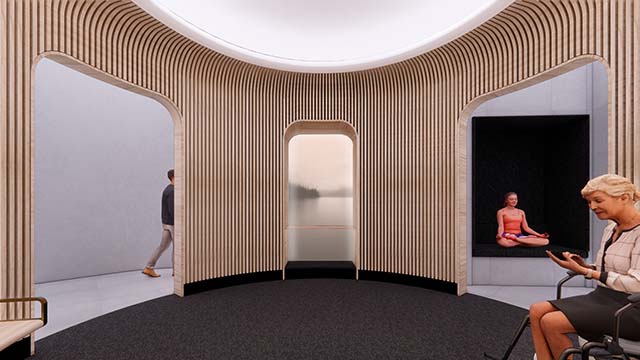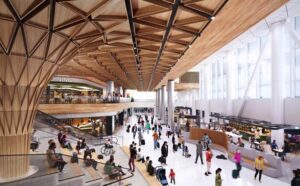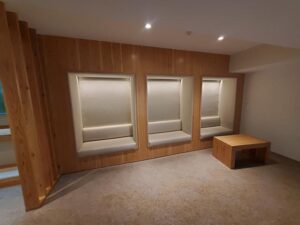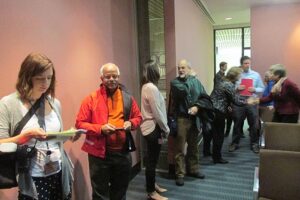Second Prayer and Meditation Room for Sea-Tac
Written by: Steve Wilhelm

The new prayer room will feature a separate meditation alcove, as well as a larger contemplative space.
Photos by: Steve Wilhelm, Port of Seattle
In just two years, Seattle-Tacoma International Airport will offer a second sheltered Interfaith Prayer and Meditation Room, where Buddhists, and others, can practice meditation.

The second site will be a sizeable round room, featuring a separate but attached meditation alcove, on the top floor of the $399 million C Concourse Expansion project. This will place the new room in the very center of the airport, a short walk from the restaurant area in the center of the terminal.
“As an international airport, a prayer and meditation room is an integral part of meeting the needs of travelers,” said Julie Collins, director of customer experience & brand strategy for the airport. “We want customers at SEA to have the amenities they need for relaxation and to be nourished spiritually and physically.”

The new room will complement the first prayer and meditation room, at 370 square feet, which opened in 2021 below the A Concourse.
For Buddhist practitioners both rooms are ideal, because both feature meditation alcoves, where a person can sit cross-legged, or in a chair, in a semi-private space. While all the alcoves open to the larger room, they’re separated from each other with sound-deadening walls. In addition the prayer and meditation rooms are quiet, separated from airport foot traffic and without public address speakers.

The first room has three alcoves and is more private, hidden away under the A concourse, so it may be preferred by serious meditators looking to practice while waiting for a flight or between flights.
The two rooms are the result of eight years of negotiations, between a diverse group of religious leaders and port leaders. Northwest Dharma Association representatives were part of the coalition, in addition to people from the Muslim Association of Puget Sound, the Jewish Federation, the Church Council of Greater Seattle, and others.

“We hope the project, and how it was initiated and carried out, will be recognized as a model for other airports and other cities,” said Northwest Dharma Association Executive Director George Draffan. “It shows that religious people of good will, and port authorities who make decisions and allocate resources, can all come together and accomplish something in harmonious cooperation.”
From 1971 to 2015 the port offered a meditation room in the mezzanine above ticketing, in the center of the main lobby. But that room had fallen into disuse after the institution of airport security, after the Sept. 11, 2001 terrorist attacks, which meant that the room was outside security and thus hard for people to use.

The second and newer prayer and meditation room will offer features for other religious traditions, while purposefully being designed to offend nobody.
For Muslims it will offer floor space for five times daily prayer, an indicator of the direction of Mecca, shoe racks and a foot-washing station. Christians will be offered an alcove to kneel and pray.
Notable in the process was the close collaboration between Buddhist and Muslim leaders, who spearheaded the effort and who testified several times before the Port of Seattle Commission. Those leaders came to understand how important a place to pray and meditate is for both traditions.

“I think for Buddhists and Muslims it is a daily part of the practice, for Muslims five times a day,” said Aneelah Afzali, executive director of the American Muslim Empowerment Network, a program of the Muslim Association of Puget Sound. “In both instances you want to have a spiritual space, an ability to have some kind of sacred space, to really reflect, to really contemplate, to achieve that connection that Buddhist siblings can relate to and Muslims as well.”
Steve Wilhelm edits Northwest Dharma News, and serves on the boards of Tibetan Nuns Project and Friends of Clear Mountain Monastery. He teaches dharma through Seattle Insight Meditation Society, especially at Eastside Insight Meditation. A former journalist, he has edited five dharma books.
